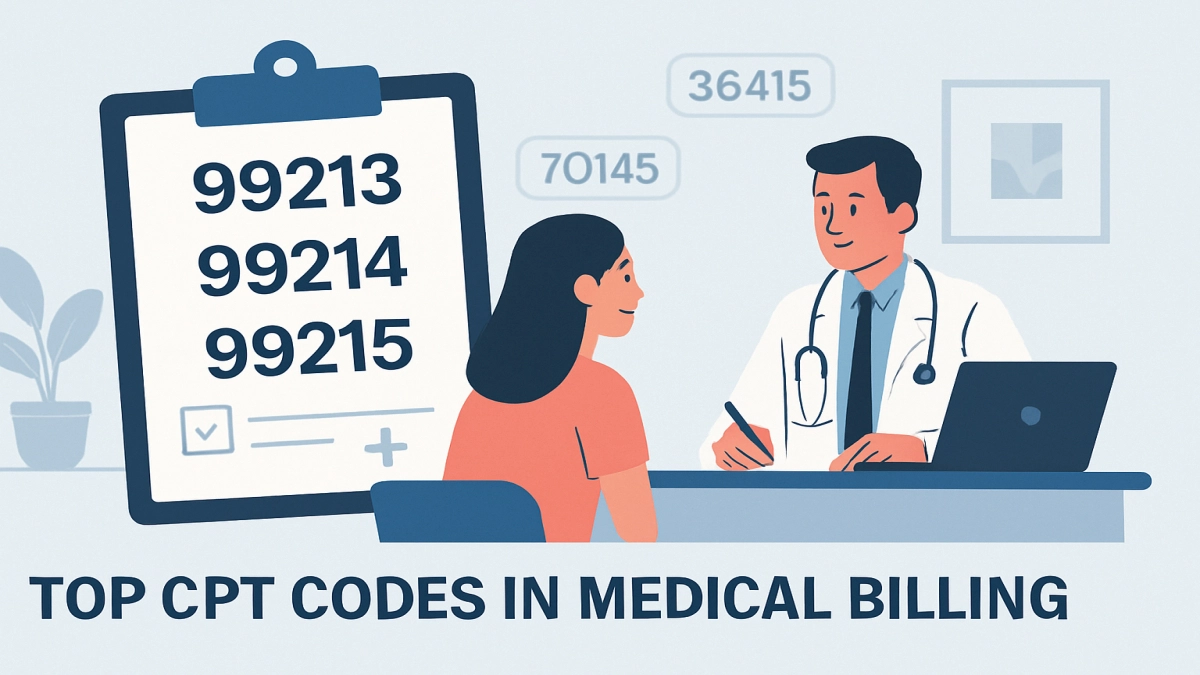In the world of medical billing, accuracy isn’t optional—it’s everything. One wrong digit in a CPT (Current Procedural Terminology) code can delay reimbursements or even cause a denial. But among the thousands of CPT codes available, some show up far more frequently than others. Understanding the most commonly used CPT codes in medical billing can streamline workflows, reduce errors, and ultimately improve revenue cycles.
This guide breaks it all down in a practical, expert-informed way—tailored for both medical billing professionals and curious readers who want to understand how CPT codes work behind the scenes.
What Are CPT Codes in Medical Billing?
CPT codes are five-digit numeric codes maintained by the American Medical Association (AMA). They are used to describe medical, surgical, and diagnostic procedures and services. Every time a patient receives care—whether it’s a routine checkup or complex surgery—CPT codes are assigned to document the service provided.
✅ Why it matters: CPT codes aren’t just for paperwork—they directly impact how healthcare providers get paid.
Top 10 Most Commonly Used CPT Codes in Medical Billing
Here’s a snapshot of the CPT codes you’re likely to see on claims every single day:
| CPT Code | Description | Typical Use |
|---|---|---|
| 99213 | Office/outpatient visit, established patient | Routine checkups, minor issues |
| 99214 | Detailed visit, established patient | More complex evaluation |
| 99203 | New patient office visit | Initial consultation |
| 36415 | Collection of venous blood by venipuncture | Routine bloodwork |
| 99283 | Emergency department visit, moderate severity | Non-life-threatening emergencies |
| 93000 | Electrocardiogram (ECG/EKG), routine | Cardiac monitoring |
| 87086 | Urine culture, bacterial | UTI or infection screening |
| 81002 | Urinalysis, non-automated without microscopy | Routine screening |
| 90658 | Influenza virus vaccine | Flu shot administration |
| 99285 | ER visit, high severity | Serious emergency treatment |
📌 Note: Usage frequency may vary slightly by specialty, region, and payer.
Why These CPT Codes Are So Common
There are three primary reasons these codes dominate medical claims:
- High-volume services like office visits and lab tests happen daily.
- Preventive care initiatives (e.g., flu vaccines) are increasingly emphasized.
- Chronic disease management leads to frequent follow-ups and lab work.
Understanding these trends can help optimize code selection, reduce claim rejections, and align billing with payer expectations.
CPT Codes vs HCPCS Codes in Medical Billing
Many new billers confuse CPT codes with HCPCS codes (Healthcare Common Procedure Coding System).
| Aspect | CPT Codes | HCPCS Codes |
|---|---|---|
| Maintained by | American Medical Association (AMA) | CMS (Centers for Medicare & Medicaid Services) |
| Code format | Five-digit numbers (e.g., 99213) | One letter + four digits (e.g., G0463) |
| Used for | Medical procedures and services | Supplies, equipment, and some services |
⚠️ Key Tip: CPT is Level I, HCPCS is Level II. Both are crucial in comprehensive billing workflows.
How to Choose the Right CPT Code for Medical Billing
Choosing the wrong code can result in denials, audits, or even accusations of fraud. Here’s how to avoid that:
- Review documentation carefully: The clinical notes should justify the level of service billed.
- Use coding tools: Software like EncoderPro, Find-A-Code, or your EMR’s built-in code assist can prevent mismatches.
- Check payer-specific policies: Some insurers have unique coding rules—especially for telehealth or bundled services.
- Keep CPT books updated annually: Codes change each year; what worked last year might be obsolete now.
Common Mistakes When Using CPT Codes
Even experienced billers can trip up. Here are frequent errors to watch for:
- Upcoding: Billing a higher-level service than documented
- Undercoding: Failing to capture all services performed
- Omitting modifiers: Forgetting essential details like -25 or -59
- Using outdated CPT codes: CPT updates yearly—stale codes = rejected claims
How to Optimize CPT Code Usage in Medical Billing
Proactive optimization leads to faster payments and cleaner claims. Here’s how:
- Regular audits of claims for coding accuracy
- Ongoing coder training and certification (e.g., CPC, CCS-P)
- Internal coding policies to maintain consistency
- Cross-department collaboration between coders, billers, and providers
Comparison of CPT Codes in Different Medical Specialties
Each specialty leans on a unique set of CPT codes. Here’s a quick overview:
| Specialty | Most Used CPT Codes |
|---|---|
| Family Medicine | 99213, 81002, 36415 |
| Cardiology | 93000, 93010, 93306 |
| Emergency Medicine | 99283, 99284, 99285 |
| Pediatrics | 90471, 99391, 90658 |
| Orthopedics | 20610, 73562, 99213 |
Benefits of Knowing Commonly Used CPT Codes
- 💼 Faster billing turnaround
- 📉 Lower denial rates
- 🧾 Improved documentation compliance
- 📚 Easier staff training and onboarding
How to Learn More About CPT Codes for Medical Billing
- Join AAPC or AHIMA for official training and certifications.
- Attend webinars or CEUs specific to CPT updates.
- Practice with real-world coding scenarios.
- Read your payer’s medical policies to understand coverage rules.
Final Takeaways
If you’re in medical billing, mastering the most commonly used CPT codes isn’t just helpful—it’s essential. These codes form the backbone of nearly every medical claim. From office visits to lab tests, understanding how and when to use them correctly can drastically improve your accuracy, reimbursement rates, and job performance.

